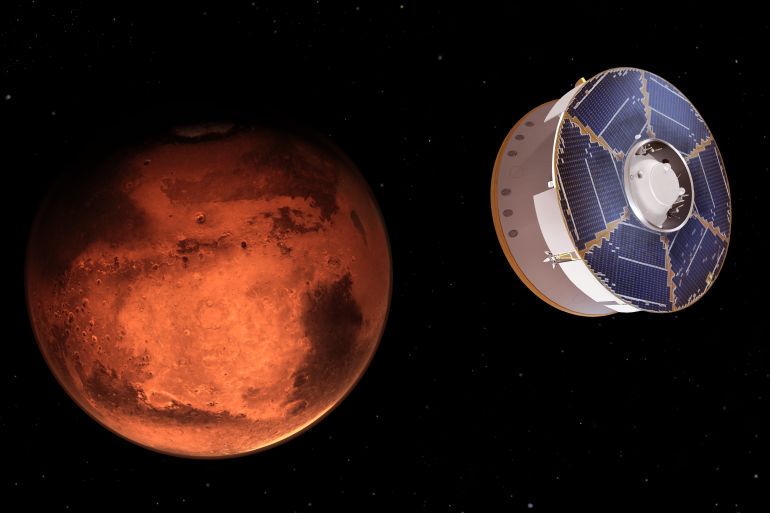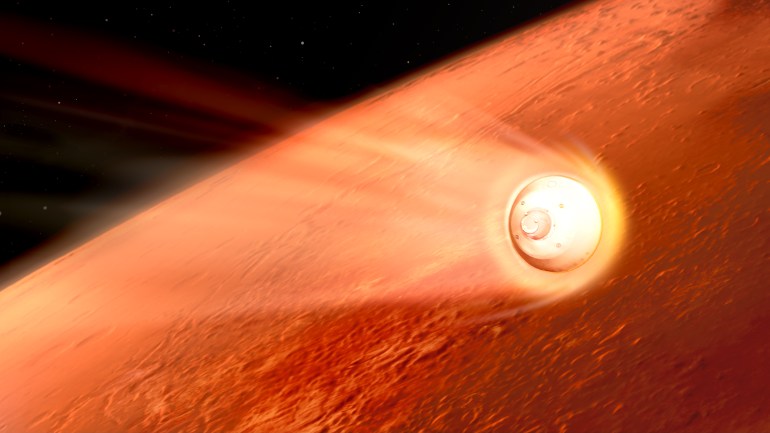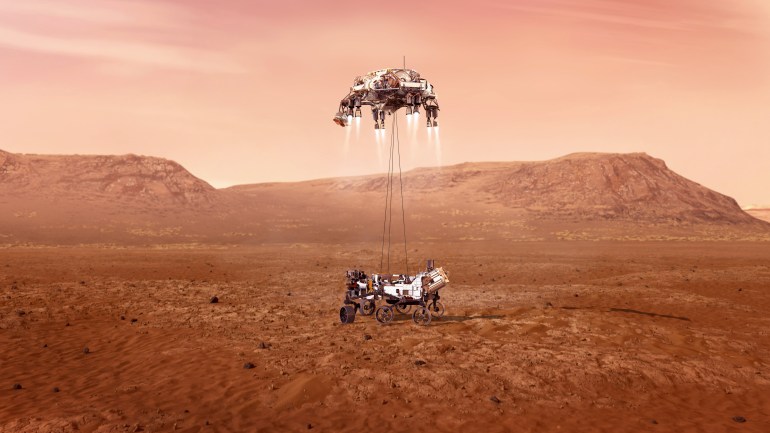NASA’s Perseverance rover carries cutting-edge tech to Mars
In a crater left by an ancient lake, the Perseverance rover will hunt for traces of microbial life, launch Mars’s first helicopter and gather rock samples to send back home.

If NASA successfully lands its fifth rover on Mars on Thursday, it will have delivered the Red Planet’s first microphones, its first aircraft, more cameras than ever before and a life-detecting duo known as SHERLOC and WATSON.
The Perseverance rover will also hopefully complete the initial step in an estimated 10-year effort to return samples of Martian rock back to Earth-bound researchers.
Keep reading
list of 4 itemsSpace race: UAE, US and Chinese missions prepare to explore Mars
UAE’s space probe Amal enters Mars orbit
Chinese spacecraft Tianwen-1 successfully enters Mars orbit
The rover carries a drill that can collect around 40 core samples, some 30 of which will be returned to Earth in the 2031 timeframe — though that plan could change.
With luck, however, scientists won’t have to wait a decade for evidence of early Martian life.
Perseverance has a laser spectrometer on board that will be able to examine rocks using different wavelengths of energy.
Attached to the end of Perseverance’s robotic arm, SHERLOC will scan rocks with deep-ultraviolet light to classify the organic materials, minerals and chemicals on their surfaces. The acronym stands for Scanning Habitable Environments with Raman & Luminescence for Organics & Chemicals.
WATSON, the Wide Angle Topographic Sensor for Operations and eNgineering, will also take microscopic images of the rocks.
Data from these and other sensors will help scientists determine whether the rocks might contain signs of fossilized microbial life.
“The science we’re going to do is spectacular,” NASA’s Luther Beegle, SHERLOC’s principal investigator, told reporters during one of two virtual NASA press conferences Tuesday.
Landing on Mars
To increase the chances of finding traces of life, NASA chose a landing site in Mars’s Jezero Crater, a basin scientists believe once contained a lake that was fed by an ancient river.
The now-dry river delta and lake bottom are not smooth, however. There are boulders and sand dunes and the delta looks like a 76m (250-foot) cliff. That information is contained in the EDL or entry, descent and landing map, which will be used by Perseverance’s Terrain-Relative Navigation (TRN) system to avoid crashing.
Perseverance will take photos during the descent that TRN will compare to the map. If there’s a hazard at the likely landing spot, Perseverance can change its course.
“This map is the best hazard map we’ve ever created for our flight mission. And it has to be because this is the information that seeds the decisions that TRN is going to be making during Perseverance’s landing,” said Erisa Stilley, the NASA systems engineer for Perseverance’s EDL landing systems.

TRN is a key tool in helping Perseverance get past the “seven minutes of terror” — the fiery period when the spacecraft enters the Martian atmosphere, transits through the atmosphere to the surface and then hopefully touches down safely.
“Landing on Mars is hard,” NASA said on its website. Of all the missions sent to Mars by any space agency, only about 40 percent have been successful, according to NASA.
A heat shield will protect Perseverance during reentry and a parachute will be used to sharply slow the spacecraft’s blistering descent. Then, like NASA’s Curiosity Mars rover before it, Perseverance will be lowered to the surface by a hovering “space crane” equipped with retrorockets.
The parachute, for which NASA had to develop a supersonic testing programme, is 70m (230 feet) across and made of Technora, Kevlar and nylon, said Adam Steltzner, Perseverance’s chief engineer.
‘A feast for the eyes and ears’
Once on the surface, Perseverance can use its collection of 25 cameras to take 360-degree colour photos, looking at Mars with both extraordinary reach and detail.
“We can resolve features on the millimetre scale close in to the rover and on the centimetre scale off at the distance. We can see, for example, something and resolve something the size of a housefly at the length of a football field,” said Jim Bell of Arizona State University in Tempe.
Bell is the principal investigator for the two Mastcam-Z cameras, each about the size of a can of tennis balls, that give Perseverance its stereo vision.
Perseverance will be bringing microphones to Mars for the first time, said Sylvestre Maurice, deputy principal investigator for the mission’s SuperCam suite, which comprises a camera, laser and spectrometers.
The microphones will enable scientists to hear the wind on Mars for the first time, which should give clues about turbulence in the atmosphere and temperature changes.
The laser hitting the rocks will also make sounds, said Maurice.
“By just listening to that, we can infer what is the hardness of the rock,” he explained.
“This mission is going to be a feast for the eyes and ears,” said Beegle.
Ingenuity’s debut
Perseverance will also be carrying a key innovation that will eventually help scientists get perspectives they cannot otherwise achieve — a petite, autonomous helicopter called Ingenuity.
Similar in appearance to a recreational drone found on Earth, Ingenuity is a technology demonstrator that will gather data on how the aircraft operates in an atmosphere that is “extremely thin — one percent compared to what we have at Earth,” said MiMi Aung, NASA’s Ingenuity project manager.
What is learned could help develop helicopters that could act as long-range scouts for rovers, get close-in photos of hard-to-reach locations like cliffsides and carry samples back to a central location.
“Larger versions could be an independent explorer directly talking to orbiters and relaying data back to Earth,” said Bob Ballerina, Ingenuity’s chief engineer, during a February webinar held by NASA and the American Institute of Aeronautics and Astronautics.

Perseverance will be carrying other sensors and systems as well. RIMFAX, the Radar Imager for Mars’ subsurFAce eXperiment, is a ground-penetrating radar that will be able to “see” up to 10m (30 feet) beneath the surface.
“That allows us to actually better understand what the structure is beneath the surface that we can see and that we’re going to be driving over,” Lori Glaze, director of NASA’s Planetary Science Division, told Al Jazeera.
MOXIE, the Mars Oxygen In-Situ Resource Utilization Experiment, is designed to convert carbon dioxide from Mars’ atmosphere to usable oxygen, a key capability for supporting broader exploration.
“Liquid oxygen is an excellent rocket propellant for the return trip on eventual human missions,” explained Jeff Sheehy, chief engineer at NASA’s Space Technology Mission Directorate.